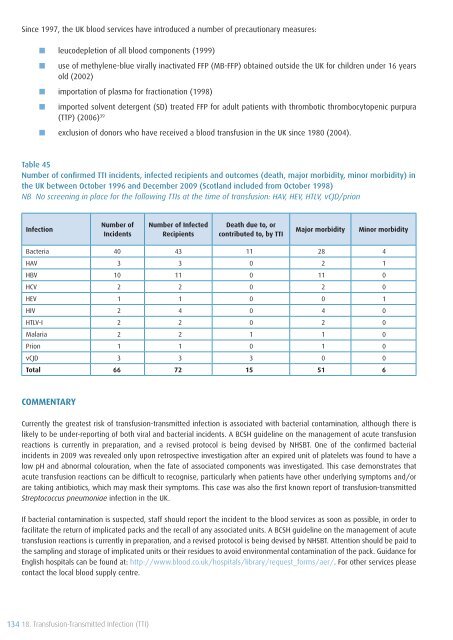SHOT Annual Report 2009 - Serious Hazards of Transfusion
SHOT Annual Report 2009 - Serious Hazards of Transfusion
SHOT Annual Report 2009 - Serious Hazards of Transfusion
Create successful ePaper yourself
Turn your PDF publications into a flip-book with our unique Google optimized e-Paper software.
Since 1997, the UK blood services have introduced a number <strong>of</strong> precautionary measures:<br />
■■<br />
■■<br />
■■<br />
■■<br />
■■<br />
leucodepletion <strong>of</strong> all blood components (1999)<br />
use <strong>of</strong> methylene-blue virally inactivated FFP (MB-FFP) obtained outside the UK for children under 16 years<br />
old (2002)<br />
importation <strong>of</strong> plasma for fractionation (1998)<br />
imported solvent detergent (SD) treated FFP for adult patients with thrombotic thrombocytopenic purpura<br />
(TTP) (2006) 39<br />
exclusion <strong>of</strong> donors who have received a blood transfusion in the UK since 1980 (2004).<br />
Table 45<br />
Number <strong>of</strong> confirmed TTI incidents, infected recipients and outcomes (death, major morbidity, minor morbidity) in<br />
the UK between October 1996 and December <strong>2009</strong> (Scotland included from October 1998)<br />
NB No screening in place for the following TTIs at the time <strong>of</strong> transfusion: HAV, HEV, HTLV, vCJD/prion<br />
Infection<br />
Number <strong>of</strong><br />
Incidents<br />
Number <strong>of</strong> Infected<br />
Recipients<br />
Death due to, or<br />
contributed to, by TTI<br />
Major morbidity<br />
Minor morbidity<br />
Bacteria 40 43 11 28 4<br />
HAV 3 3 0 2 1<br />
HBV 10 11 0 11 0<br />
HCV 2 2 0 2 0<br />
HEV 1 1 0 0 1<br />
HIV 2 4 0 4 0<br />
HTLV-I 2 2 0 2 0<br />
Malaria 2 2 1 1 0<br />
Prion 1 1 0 1 0<br />
vCJD 3 3 3 0 0<br />
Total 66 72 15 51 6<br />
COMMENTARY<br />
Currently the greatest risk <strong>of</strong> transfusion-transmitted infection is associated with bacterial contamination, although there is<br />
likely to be under-reporting <strong>of</strong> both viral and bacterial incidents. A BCSH guideline on the management <strong>of</strong> acute transfusion<br />
reactions is currently in preparation, and a revised protocol is being devised by NHSBT. One <strong>of</strong> the confirmed bacterial<br />
incidents in <strong>2009</strong> was revealed only upon retrospective investigation after an expired unit <strong>of</strong> platelets was found to have a<br />
low pH and abnormal colouration, when the fate <strong>of</strong> associated components was investigated. This case demonstrates that<br />
acute transfusion reactions can be difficult to recognise, particularly when patients have other underlying symptoms and/or<br />
are taking antibiotics, which may mask their symptoms. This case was also the first known report <strong>of</strong> transfusion-transmitted<br />
Streptococcus pneumoniae infection in the UK.<br />
If bacterial contamination is suspected, staff should report the incident to the blood services as soon as possible, in order to<br />
facilitate the return <strong>of</strong> implicated packs and the recall <strong>of</strong> any associated units. A BCSH guideline on the management <strong>of</strong> acute<br />
transfusion reactions is currently in preparation, and a revised protocol is being devised by NHSBT. Attention should be paid to<br />
the sampling and storage <strong>of</strong> implicated units or their residues to avoid environmental contamination <strong>of</strong> the pack. Guidance for<br />
English hospitals can be found at: http://www.blood.co.uk/hospitals/library/request_forms/aer/. For other services please<br />
contact the local blood supply centre.<br />
134 18. <strong>Transfusion</strong>-Transmitted Infection (TTI)












